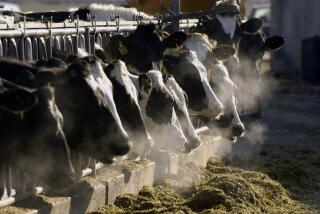Lardo di Colonnata, aged in marble, is an endangered delight.
- Share via
COLONNATA-CARRARA, Italy — Layered beneath Fausto Guadagni’s hillside home here are four basements full of marble vats that resemble coffins, prayed over by a marble Christ. The spooky descent into the cool, damp labyrinth brings a pungent surprise.
For centuries, this Tuscan village lived off the prized Carrara marble extracted by its inhabitants from quarries high in the surrounding Apuan Alps. As the quarries became mechanized and the village population dwindled to 300, residents looked to their basements for economic salvation.
Guadagni, 44, is the leading producer of lardo di Colonnata, a gleaming white pig fat cured in those basement vats between layers of sea salt, local herbs and spices. If that sounds disgusting, read on. First developed as a high-calorie fuel for lowly quarry workers, lardo di Colonnata has lately become a $10-per-pound delicacy coveted by chefs throughout Italy and beyond.
But this is not yet a success story. Despite the willingness of gastronomes across Europe to pay dearly for obscure regional specialties, products such as lardo di Colonnata are fighting for survival--in part because of European Union sanitary regulations.
The trouble with lardo started one night in 1996 when Italian police raided the basements of Guadagni and four other producers here, confiscated their pig fat and fined them thousands of dollars for trading the stuff--as their ancestors had for ages--without health permits.
A year later, the producers were outraged again when Italian health inspectors tried to ban the use of marble vats for curing their fat, citing new EU guidelines requiring that containers used in the commercial preparation of food be made of a nonabsorbent material such as germ-resistant plastic or stainless steel.
Backed by the Italian-based Slow Food movement, which lobbies to protect traditional foods, the producers circulated petitions, made televised appeals to Italian nationalism and won the battle in Rome.
They argued that lardo di Colonnata would lose its identity if cured in anything but marble, whose porous, calcium carbonate surface helps the fat create a salty brown brine during the six-month aging process and absorbs much of the cholesterol. They also produced studies by Italian universities showing the final product to be free of bacteria.
“The olive oil we use to coat the marble is a natural enemy of bacteria, and so is the salt we put between layers of fat,” says Guadagni, removing a brick-size block of cured fat from the brine. “This product has survived for centuries because it’s tasty, safe and simple to make.”
The cured fat has a light, buttery texture and a sweet, subtle aroma. In the restaurant he also owns, Guadagni serves it in paper-thin slices on warm bread or on a plate with fig jam or fresh tomatoes. He sells most of his 10-ton annual output to an Italy-wide distributor and exports some to Switzerland and Sweden under an EU seal of approval obtained in 1998 after Italian inspectors waived their ban on marble vats.
Indeed, Italian specialty producers seem to have a talent for winning these exceptions from their government. This may be true partly because Italian-based Slow Food is such a strong lobby, and partly because Italy’s center-left government is sensitive to protests by small producers who appeal to Italian nationalism in defense of obscure but endangered regional specialties.
But a new battle looms. In the throes of the scare generated by mad cow disease, the European Union is preparing new legislation that would empower it to review such waivers--including more than 700 granted by Italy to producers of traditional dishes--and subject the waivers to a common standard.
That means the question of pig fat in marble vats could go before European technical and scientific review boards as early as this year, say officials at EU headquarters in Brussels.
Richard North, a food safety specialist and researcher at the European Parliament, says the expected ruling on vats will be a clear test of the EU Health and Consumer Safety Commission’s stated intent to move away from rigid prohibitions toward a more flexible, case-by-case approach to risk evaluation.
“If the Italians can demonstrate that there’s no significant risk, then the commission should not interfere,” North said. “The problem is that, at the Brussels level, the regulators tend toward caution bordering on paranoia. This case is going to be the proof of the pudding--or the proof of the pig fat.”
Meanwhile, Guadagni and Colonnata-Carrara’s nine other lardo producers are focused on a threat closer to home.
A consortium of businesspeople from elsewhere in Tuscany is mass-producing pig fat using an accelerated curing process with chemical additives and marketing it as lardo di Colonnata. Guadagni’s group and the rival consortium are each asking the Italian government for the exclusive right to the famed product name.
For Slow Food and other traditionalists, the battle is between an authentic local product and an industrial imitation that threatens to drive the local product off the market and jeopardize the livelihood of an entire village.
“If we lose,” Guadagni says, looking around his multitiered basement, “we might as well close up shop, emigrate to California and make fruit preserves.”
More to Read
Eat your way across L.A.
Get our weekly Tasting Notes newsletter for reviews, news and more.
You may occasionally receive promotional content from the Los Angeles Times.










